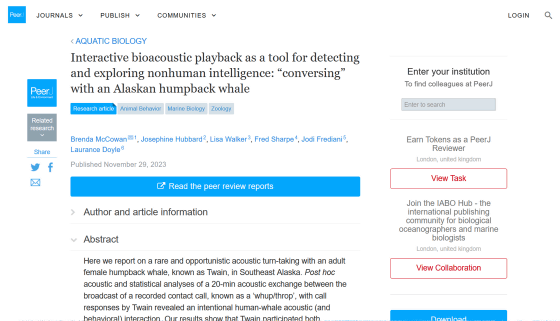A whale and a scientist succeeded in having a 20-minute 'conversation', and it may also be useful for contacting extraterrestrial life forms

A research team led by scientists
Interactive bioacoustic playback as a tool for detecting and exploring nonhuman intelligence: “conversing” with an Alaskan humpback whale [PeerJ]
https://peerj.com/articles/16349/

Whale-SETI: Groundbreaking Encounter with Humpback Whales Reveals Potential for Non-Human Intelligence Communication
https://www.seti.org/press-release/whale-seti-groundbreaking-encounter-humpback-whales-reveals-potential-non-human-intelligence
World's 1st 'conversation' between humans and whales could help us talk to aliens someday, scientists claim | Live Science
https://www.livescience.com/space/extraterrestrial-life/worlds-1st-conversation-between-humans-and-whales-could-help-us-talk-to-aliens-someday-scientists-claim
The surprising reason why alien hunters had a 20-minute 'conversation' with a humpback whale
https://www.zmescience.com/science/news-science/humbpack-whale-communication/
Whales are highly intelligent and have complex social systems, using vocalizations to communicate with their fellow whales. For this reason, many researchers are conducting research to understand the language of whales, and efforts are also underway to analyze whale sounds using AI.
A research team including the University of California, Davis, the Alaska Whale Foundation , and SETI recorded high-quality recordings of humpback whales' greeting calls called 'whup' or 'throp' off the coast of Alaska in August 2021. The next day, they played the recorded calls through the ship's underwater speakers to see if the humpback whales would respond.
Experiments confirmed that a humpback whale named Twain not only approached and circled the ship when it heard the speaker's calls, but also responded to the speaker's calls as if they were a conversation. Twain responded to each of the more than 30 calls made by scientists over a 20-minute period, and rose to the surface seven times during that time.
The diagram below shows when and where Twain surfaced as he circled the ship.

It is also reported that when the research team changed the timing of the cry, Twain also changed the timing of his response. In other words, when the research team waited 30 seconds after Twain's reply and played the cry, Twain also responded after about 30 seconds. This suggests that Twain was not just randomly chirping back, but was intentionally participating in a 'conversation'-like communication.
'We believe this is the first time humans and humpback whales have communicated in humpback language,' said lead author Dr. Brenda McCowan of the University of California, Davis.
Scientists at SETI, which searches for extraterrestrial life, are participating in this study because they believe communication between humans and humpback whales will help them detect and interpret signals sent to Earth by extraterrestrial life. Because we think it's helpful. According to SETI, a system that communicates with intelligent animals living on Earth (such as humpback whales) could lead to the development of filters that can be applied to received extraterrestrial signals.
Dr Laurence Doyle, SETI scientist and co-author of the paper, said: ``Due to the limitations of modern science and technology, a key assumption in the search for extraterrestrial intelligence is that extraterrestrial life is 'They will target human receivers who are interested in contacting them. This important assumption is certainly supported by humpback whale behavior.'

Related Posts:







